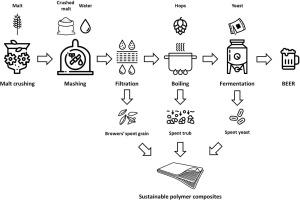当前位置:
X-MOL 学术
›
Waste Manag.
›
论文详情
Our official English website, www.x-mol.net, welcomes your feedback! (Note: you will need to create a separate account there.)
More than just a beer – Brewers' spent grain, spent hops, and spent yeast as potential functional fillers for polymer composites
Waste Management ( IF 8.1 ) Pub Date : 2024-03-19 , DOI: 10.1016/j.wasman.2024.03.023 Aleksander Hejna , Mateusz Barczewski , Paulina Kosmela , Joanna Aniśko , Joanna Szulc , Katarzyna Skórczewska , Adam Piasecki , Tairong Kuang
Waste Management ( IF 8.1 ) Pub Date : 2024-03-19 , DOI: 10.1016/j.wasman.2024.03.023 Aleksander Hejna , Mateusz Barczewski , Paulina Kosmela , Joanna Aniśko , Joanna Szulc , Katarzyna Skórczewska , Adam Piasecki , Tairong Kuang

|
Beer is among the most popular beverages in the world, with the production distributed uniformly between the biggest continents, so the utilization of brewing by-products is essential on a global scale. Among their potential recipients, the plastics industry offers extensive range of potential products. Herein, the presented study investigated the application of currently underutilized solid brewing by-products (brewers' spent grain, spent hops, spent yeast) as fillers for highly-filled poly(ε-caprolactone)-based composites, providing the first direct connection between spent hops or spent yeast and the polymer composites. Comprehensive by-product characterization revealed differences in chemical composition. The elemental C:O ratio, protein content, and Trolox equivalent antioxidant capacity varied from 1.40 to 1.89, 12.9 to 32.4 wt%, and 2.41 to 10.24 mg/g, respectively, which was mirrored in the composites' structure and performance. Morphological analysis pointed to the composition-driven hydrophilicity gap limiting interfacial adhesion for high shares of brewers' spent grain and spent hops, due to high hydrophilicity induced by carbohydrate content. Phytochemicals and other components of applied by-products stimulated composites' oxidative resistance, shifting oxidation onset temperature from 261 °C for matrix over 360 °C for high spent yeast shares. Simultaneously, spent yeast also provided compatibilizing effects for poly(ε-caprolactone)-based composites, reducing complex viscosity compared to other fillers and indicating its highest affinity to poly(ε-caprolactone)due to the lowest hydrophilicity gap. The presented results indicate that the proper selection of brewing by-products and adjustment of their shares creates an exciting possibility of engineering composites' structure and performance, which can be transferred to other polymers differing with hydrophilicity.
中文翻译:

不仅仅是啤酒——啤酒厂的废谷物、废啤酒花和废酵母作为聚合物复合材料的潜在功能性填料
啤酒是世界上最受欢迎的饮料之一,其产量均匀分布在各大洲之间,因此啤酒副产品的利用在全球范围内至关重要。在潜在的接收者中,塑料行业提供了广泛的潜在产品。在此,本研究调查了目前未充分利用的固体酿造副产品(啤酒糟、啤酒花、废酵母)作为高填充聚(ε-己内酯)基复合材料的填料的应用,提供了第一个直接联系废啤酒花或废酵母和聚合物复合材料。全面的副产品表征揭示了化学成分的差异。元素 C:O 比例、蛋白质含量和 Trolox 当量抗氧化能力分别为 1.40 至 1.89、12.9 至 32.4 wt% 和 2.41 至 10.24 mg/g,这反映在复合材料的结构和性能中。形态分析指出,由于碳水化合物含量引起的高亲水性,成分驱动的亲水性间隙限制了高比例啤酒糟和废啤酒花的界面粘附力。应用副产品中的植物化学物质和其他成分刺激了复合材料的抗氧化性,将基质的氧化起始温度从 261 °C 转变为高废酵母份额的 360 °C。同时,废酵母还为聚(ε-己内酯)基复合材料提供了增容作用,与其他填料相比,降低了复数粘度,并且由于亲水性差距最低,表明其与聚(ε-己内酯)的亲和力最高。研究结果表明,正确选择酿造副产品并调整其比例为工程复合材料的结构和性能创造了令人兴奋的可能性,可以将其转移到具有不同亲水性的其他聚合物。
更新日期:2024-03-19
中文翻译:

不仅仅是啤酒——啤酒厂的废谷物、废啤酒花和废酵母作为聚合物复合材料的潜在功能性填料
啤酒是世界上最受欢迎的饮料之一,其产量均匀分布在各大洲之间,因此啤酒副产品的利用在全球范围内至关重要。在潜在的接收者中,塑料行业提供了广泛的潜在产品。在此,本研究调查了目前未充分利用的固体酿造副产品(啤酒糟、啤酒花、废酵母)作为高填充聚(ε-己内酯)基复合材料的填料的应用,提供了第一个直接联系废啤酒花或废酵母和聚合物复合材料。全面的副产品表征揭示了化学成分的差异。元素 C:O 比例、蛋白质含量和 Trolox 当量抗氧化能力分别为 1.40 至 1.89、12.9 至 32.4 wt% 和 2.41 至 10.24 mg/g,这反映在复合材料的结构和性能中。形态分析指出,由于碳水化合物含量引起的高亲水性,成分驱动的亲水性间隙限制了高比例啤酒糟和废啤酒花的界面粘附力。应用副产品中的植物化学物质和其他成分刺激了复合材料的抗氧化性,将基质的氧化起始温度从 261 °C 转变为高废酵母份额的 360 °C。同时,废酵母还为聚(ε-己内酯)基复合材料提供了增容作用,与其他填料相比,降低了复数粘度,并且由于亲水性差距最低,表明其与聚(ε-己内酯)的亲和力最高。研究结果表明,正确选择酿造副产品并调整其比例为工程复合材料的结构和性能创造了令人兴奋的可能性,可以将其转移到具有不同亲水性的其他聚合物。



























 京公网安备 11010802027423号
京公网安备 11010802027423号